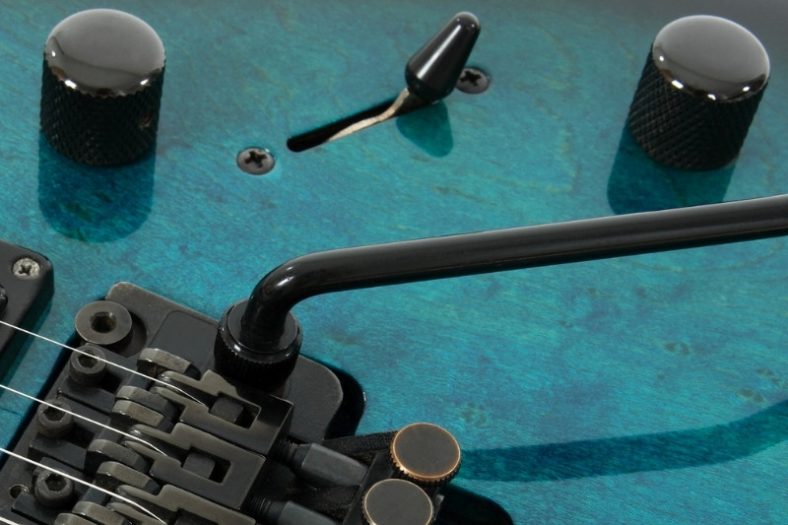Bass Guitars With Whammy Bars

The whammy bar or the tremolo (vibrato) system is common on most electric guitars nowadays but is seldom seen on bass guitars. Because of stronger tension from the bass strings, plus the low relevance it has on a bass guitar, most bassists avoid and/or have not implemented this system too much.
For a long time, electric guitars were considered the ultimate soloist tool which is still the case today. However, bass playing has also been brought to light in recent years, particularly solo bassists experimenting and taking the instrument further.
Whammy bars are a common sight on most electric guitars and bring the solo game to a new level, bass guitars on the other hand have rarely seen a tremolo system. Have you ever wondered why that is?
Today, let’s take a look at why whammy bars are less common on bass guitars.
Contents
What is a Whammy Bar?
Before going any further, it is important to understand what a whammy bar is and how it has been used in the past.
A whammy bar is a crucial invention in guitar history that serves as a pitch variation feature that works by bending the tension of all of the strings at the same time. The result is bending notes to create different sounds or dives, commonly used when soloing. The system works by attaching a metal arm to the bridge that can be pressed, pulled, etc.
The whammy bar has been used extensively since its invention, creating memorable sounds like motorcycle revving, squeals, mimicking animal sounds, and creating electrifying dive bombs. This is why they are considered the ultimate solo tool.
Can a bass guitar have a whammy bar?
Bass guitars can indeed have whammy bars. Many famous bassists throughout history have used a whammy bar on their bass at one point. Some have even built signature sounds from it. Some memorable names you might recognize are Victor Wooten and Les Claypool, among many others.
Why are whammy bars rarely seen on bass guitars?
The reason why whammy bars are not seen on bass guitars often is because they do not provide much versatility to the sound and some even question the safety due to the strong string tension on bass.
Naturally, having a whammy bar on bass will produce roughly the same result that it does on an electric guitar. Note bends will become accessible and you can have fun while doing a solo or just playing around. However, the relevance of a vibrato system is also in question here, the note bends on the bass are not all that noticeable like on the electric guitar, therefore, some might ask what’s the point?
Granted, spicing up your playing style is a good enough reason but considering the pitch variation on the bass and the stress it puts on the already tight tension on the strings, it’s not worth it in most cases.
To put it simply, whammy bars on bass are mostly for show and a little bit of fun. Those who have used it have done so to stand out and do something different.
What are the effects of a whammy bar on bass?
A whammy bar, while creative and cool-sounding to an extent, can have negative effects on your bass guitar, particularly the bridge and strings. Not saying that it will ruin your bass guitar, but it will slowly chip away at your string tension and result in more out-of-tune strings.
Granted, tuning your guitar is a must each time before playing, but considering the overall relevance of this system on bass guitars, most choose to avoid it in most cases.
The other factor you need to consider is the price of this system. Most bases don’t come with a built-in whammy bar, naturally, you would have to pay to get one installed and it can be costly.
I guess the most important question is – Is a whammy bar for bass a good investment? The answer is simple, it’s up to you to decide. If you want to bring some fun into your playing and have the budget to do so then yes, a whammy bar can come in handy. If you’re wondering about the relevance and if a vibrato system is crucial to your sound, it is certainly not.
What are some examples of whammy bars on bass?
There are some great examples of bass guitars with whammy bars throughout music history, particularly if you look at Les Claypool’s bass solo and what he does with the whammy bar and his sheer skill on the bass.
Victor Wooten had a whammy bar on some of his bass guitars, though he did not use it that much. But, it’s not just about the wobbly sound, even the Law & Order theme song has a bass dive in the soundtrack.
There are countless bass solos all over Youtube of bassists playing solos with the whammy bar, just a simple search will give you a lot of examples of how it’s used and what the actual sound is like on bass.
Conclusion
Whammy bars on bass are not all that common because of their low relevance to the bass sound. Yes, they can produce interesting sounds and add a creative flair to your playing, but in most cases, they are more trouble than they’re worth. If you’re thinking about getting a whammy bar for your bass, make sure you weigh the pros and cons carefully before making a decision.





